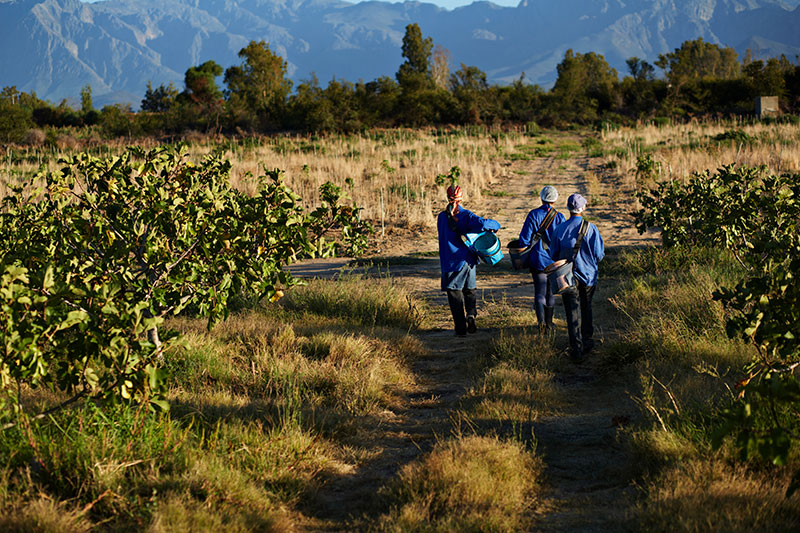Fertiliser from urine: winning master’s research underscores SDGs
27 September 2021 | Story Helen Swingler. Read time 8 min.
Human urine is treated as a mere waste product, millions of litres flushed away daily. But this liquid gold is rich in nitrogen in the form of urea, which is most often used as a fertiliser. University of Cape Town (UCT) civil engineering master’s candidate Hlumelo Marepula has won an award for producing a urea-ethanol solution that can be recrystallised to produce fertiliser (urea) and potentially diesel engine fluid with water as a by-product.
For an ecologically threatened planet seeking greater sustainability, the potential is significant, particularly for Africa’s rural farmers. Marepula presented her winning research in a three-minute video at the recent virtual International Summit on Sustainable Development Goals (SGDs) Africa hosted at UCT from 13 to 15 September.
The competition was open to master’s and doctoral candidates and was part of the virtual International Summit on Sustainable Development Goals (SDGs) in Africa, hosted by UCT from 13 to 15 September. The primary focus of the summit was the United Nations SDGs, a shared blueprint for working towards global peace and prosperity by 2030. The summit also aimed to integrate the main strategic framework guiding policymaking across the African continent – the African Union’s Agenda 2063: The Africa We Want.
The three-minute videos were intended to show how:
- the entrants’ research addresses #TheAfricaWeWant
- the research accelerates the achievement of the SDGs and Agenda 2063.
Submissions came from South Africa, Ethiopia, Nigeria, the Netherlands, Hungary, Ghana, Tanzania, Mauritius, Australia and the United Kingdom. The winners were chosen by summit attendees. The runners-up were UCT’s Bongekile Mabaso with a presentation titled ‘Supervisory support for breastfeeding at work: perspective from the South African public sector’ and Fadzai Kadzinga, whose presentation focused on the microbial treatment of mine wastewater.
The same topic took laurels for Marepula in the 2019 Falling Walls Lab Cape Town competition. She explored the potential of human urine to produce jet fuel. Marepula went on to represent UCT and South Africa at the global finals in Berlin, Germany.
Changing African farming
Marepula’s ground-breaking research underpins her master’s thesis in water quality engineering and environmental sustainability in the Department of Civil Engineering and the Future Water Institute, and supervised by Associate Professor Dyllon Randall. Associate Professor Randall and his students have won numerous honours for this body of work. To cap her achievement, Marepula has also just published her first paper on the process in Chemical Engineering Journal Advances. The paper was co-authored by Randall and PhD student Caitlin Courtney.
“… fertilisers for food production in Africa remains very low because these synthetic [urea-based] fertilisers are often expensive.”
Marepula is hoping to change the face of Africa’s agricultural sector.
“Africa has the largest area of arable land in the sub-Saharan region, accounting for 20% of the global agricultural land by area,” she said in her video. “However, fertilisers for food production in Africa remains very low because these synthetic [urea-based] fertilisers are often expensive for most small-scale farmers.”

Why urea?
“Urea is an important source of nitrogen with more than 90% of the world’s synthetic urea used as fertiliser,” Marepula explained. “Because of its high nitrogen content, urea also has the lowest transportation costs compared with other fertilisers. Globally, synthetic urea is the most abundantly produced chemical. But the process operates at high temperatures and pressures and is energy‑intensive.”
Alternative urea production methods are required to reduce energy consumption, greenhouse gas emissions and costs while also using waste streams in a more circular economy approach. It was important for Marepula that her work develop an alternative, affordable and sustainable way of producing urea from plentiful, ubiquitous human urine. In doing so, she could use waste streams in a circular economy approach – and address multiple SDGs, including responsible consumption and production and zero hunger.
Solid science
Urea is usually produced indirectly using the Haber-Bosch process. This adds nitrogen from the air with hydrogen from natural gas at high temperatures and very high pressures to produce ammonia.
The challenge of extracting urea from human urine is that the urea quickly degrades to ammonia and carbonate ions in the presence of urease-producing bacteria. Capturing the urea becomes challenging.
Marepula investigated the feasibility of recovering and purifying urea crystals from human urine using a novel ethanol evaporation and recrystallisation process that exploits the solubility differences of urea and impurities in water and ethanol.
“We started by collecting the urine using waterless urinals and then treated it,” she explained. “Urine is made mainly of water, urea and various other components. We isolated the water by evaporating it from the urine at room temperature. This produced a solid product of urea and impurities with a urea purity of 42%. This was not good enough for us, so we improved the purity by adding ethanol.”
Adding ethanol to the solid product dissolved all the urea and left the undissolved impurities behind to be filtered out, she said.
“This resulted in a urea-ethanol solution which was then recrystallised by evaporating the ethanol.”
The purity of the urea was then increased by between 76% and 91% using this method.
“We then designed a system treating 1 000 litres of urine per day, which could potentially recover 11.5 kilograms of calcium phosphate, a by-product of the urine treatment process and a potential fertiliser and 20 kg of urea.”
Win-win
The process could yield a niche urea liquid fertiliser and the remainder could potentially be used to make diesel engine fluid, used to reduce air pollution caused by vehicles.
“A pilot-scale urea recovery system should be built, commissioned and tested.”
“In addition, water could be recovered through this process and used to make these products and, here’s a bonus: ethanol can be condensed back into a liquid and reused.”
The prospect has fired her determination and Marepula argues that more research is imperative.
“Future work should also investigate whether urea recovery at higher temperatures can significantly improve the rate of evaporation and, ultimately, the purity and yield or urea. Finally, a pilot-scale urea recovery system should be built, commissioned and tested.”
Randall commented: “Hlumelo has constantly impressed me with her intellect, dedication and passion for making the world a better place. I am immensely proud of her. I also see so much potential in this work and I’m excited by where it will lead.”
 This work is licensed under a Creative Commons Attribution-NoDerivatives 4.0 International License.
This work is licensed under a Creative Commons Attribution-NoDerivatives 4.0 International License.
Please view the republishing articles page for more information.










